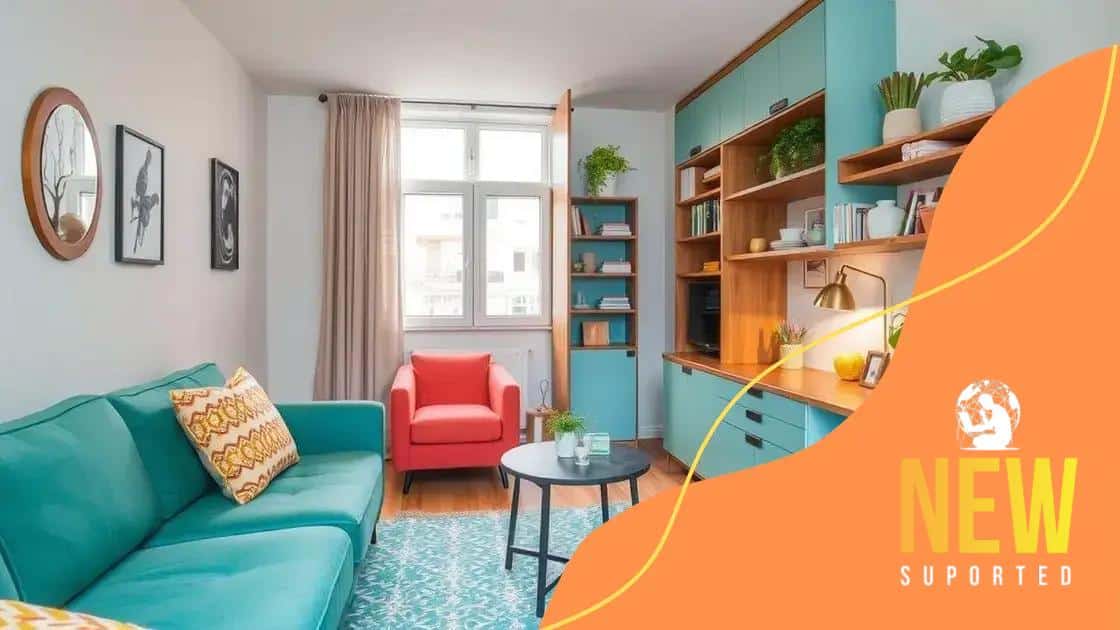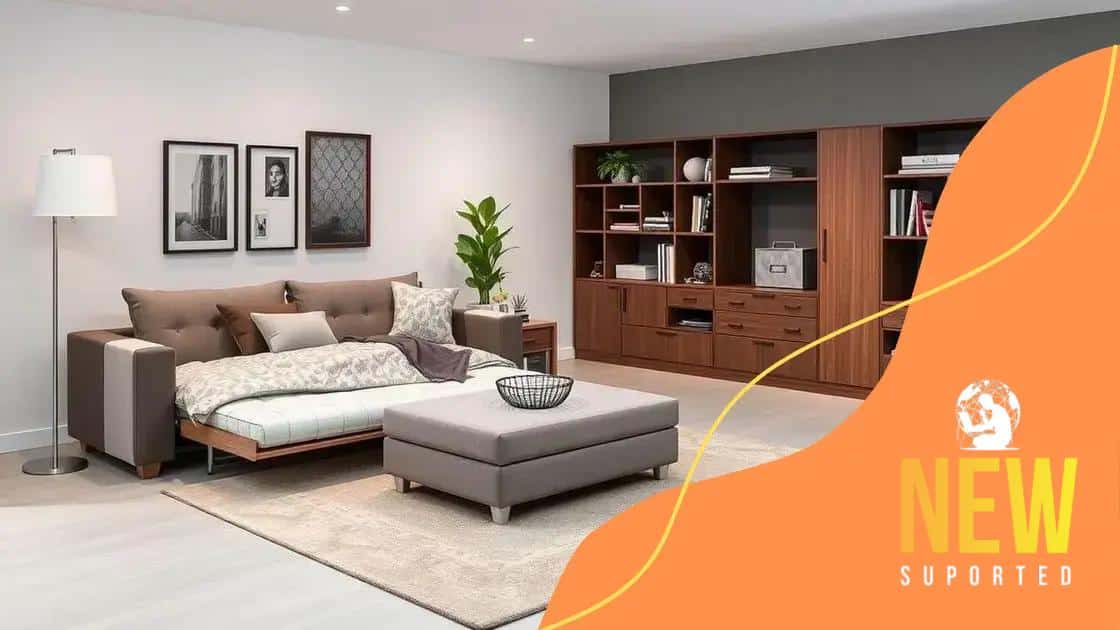How to maximize small space living with home design

To maximize small space living with home design, utilize multi-functional furniture, light color palettes, smart storage solutions, and layered lighting strategies to create a functional and inviting environment.
How to maximize small space living with home design can feel daunting, yet with the right strategies, your cozy home can become a stylish haven. What if you could enhance every corner without sacrificing comfort?
Smart furniture choices for small spaces
Choosing smart furniture is essential when it comes to maximizing small space living. Selecting the right pieces can transform your compact area into a functional and stylish environment. It’s all about making clever decisions that allow you to enjoy every inch of your home.
Versatile Furniture Options
When shopping for furniture, consider multi-functional pieces. A sofa bed, for instance, works perfectly for guests while providing a comfortable spot during the day. Foldable tables and nesting chairs are also great for saving space when not in use.
- Storage ottomans can serve dual purposes.
- A wall-mounted desk can free up floor space.
- Murphy beds are excellent for small bedrooms.
- Use bookshelves as room dividers.
The key to effective small space living is understanding how to maximize functionality without compromising style. For example, consider choosing furniture made from light-colored materials that can reflect light and make the room feel larger.
Choosing the Right Materials
Opting for light, airy materials can help create a sense of openness. Glass tables, for example, provide a sleek look while remaining visually unobtrusive. Additionally, incorporating mirrors can enhance light and space perception. These small adjustments can make a significant difference.
Don’t forget to consider the scale of your furniture. Oversized furniture can overwhelm a small space, making it feel cramped. On the other hand, petite, sleek lines add elegance without bulk.
Incorporating built-in storage solutions is another intelligent choice. Consider under-bed storage or sofas with built-in compartments. Maximizing vertical space with shelves can also free up floor area, making your living space more breathable.
Color palettes that create a sense of space
When it comes to maximizing small space living, color palettes play a crucial role. The right colors can create a sense of openness and make a tiny room feel larger. Light and neutral shades, for instance, reflect more light, which brightens up spaces and enhances their appearance.
Choosing Light Colors
Using a palette of soft pastel or light colors is an effective approach. Shades like pale blue, soft gray, or light beige can open up a room, making walls appear further away. These colors act as a blank canvas, giving a feeling of airy comfort.
- Whites create a fresh and spacious atmosphere.
- Pale hues add warmth without closing in the space.
- Mixing light colors can prevent monotony, making the space feel dynamic.
Incorporating accent walls can add depth and maintain interest. A single wall painted in a deeper hue allows for creativity while keeping the overall feel bright. This approach can make the room feel layered and sophisticated without overwhelming it.
Using Color Strategically
The placement of color is also vital. Consider painting the ceiling a lighter shade than the walls. This technique draws the eye upward, creating an illusion of higher ceilings, which can significantly enhance the sense of space. Another tip is to use the same color for walls, trim, and moldings to create a flowing look.
In terms of flooring, light-colored rugs can help ground the space while maintaining an open feel. You can also use color to designate different areas in an open floor plan. Subtle variations in shades can help differentiate functional areas, providing both style and organization.
Adding mirrors can complement your color choices as well. They reflect colors and light, further enhancing the brightness and spaciousness of a room. When paired with a thoughtful color palette, mirrors amplify the overall design, making even the smallest spaces feel expansive.
Multi-functional design elements

In small spaces, multi-functional design elements are key to unlocking the potential of every room. By choosing furniture and decor that serve more than one purpose, you can maximize efficiency and create a versatile living space.
Selecting Versatile Furniture
When looking for furniture, consider items that can adapt to your needs. A sofa bed is a classic example; it provides seating during the day and transforms into a bed at night. Similarly, an extendable dining table allows for intimate meals and can expand for entertaining guests.
- Storage ottomans work as seating and storage.
- A coffee table with drawers offers place settings and keeps the area tidy.
- Murphy beds provide sleeping space without sacrificing floor area.
Additionally, modular furniture can be reconfigured to suit different occasions. For example, sectional sofas can be rearranged as needed based on your layout and social gatherings. It’s all about enhancing the flow of your small space.
Creative Storage Solutions
Incorporating smart storage solutions into your design can also create additional functionality. Think about built-in shelves that provide both storage and display space. Utilizing vertical space with shelving not only helps reduce clutter but also draws the eye upward, making the room feel larger.
Another effective strategy is to use furniture that hides compartments. Beds with storage underneath or benches that open up can help you maintain an organized environment while keeping essential items close at hand. Even decorative boxes can serve a purpose, combining style and storage.
Decluttering your living space is crucial for an inviting atmosphere. You can also incorporate hidden features in furniture. For instance, a console table with USB charging ports keeps the area tidy and functional. This approach enhances usability without sacrificing aesthetics.
Storage solutions to declutter effectively
Effective storage solutions are essential for decluttering small spaces. By organizing your belongings with purpose, you can create a clean and functional environment. It’s all about being strategic with what you have and how you use it.
Utilizing Vertical Space
One of the best ways to optimize storage is to go up. Use shelves that reach the ceiling to take advantage of vertical space. This not only provides more room for items but also draws the eye upward, making the space feel larger.
- Install floating shelves to display books and decor.
- Consider tall bookshelves for maximum storage.
- Use hook racks for hanging items like bags or coats.
Incorporating baskets on the shelves can also help keep things organized. They create a neat look while allowing you to store smaller items out of sight. Labeling these baskets adds functionality and helps everyone know where things belong.
Multi-Use Furnishings
An excellent investment for small spaces is multi-use furniture. Pieces like benches with storage or ottomans that open up can serve a dual purpose. This way, they provide seating and also hold items you want to keep handy but out of the way.
Another clever idea is to choose furniture that offers hidden compartments. For example, a bed with drawers underneath can store seasonal clothing or extra linens without taking additional floor space. All these features work together to create a streamlined look.
Additionally, consider making use of closet organizers. Hanging racks, tiered shoe shelves, and drawer dividers can all contribute to a more organized closet. It prevents items from piling up and makes it easier to find what you need.
Lighting strategies to enhance ambiance
Lighting is a vital element in enhancing ambiance, especially in small spaces. The right lighting can create warmth and make a room feel inviting. It’s important to layer your lighting instead of relying on a single light source.
Layering Your Lighting
To effectively illuminate your space, combine ambient, task, and accent lighting. Ambient lighting provides general illumination and sets the overall mood. Task lighting focuses on areas where you need more light for activities, such as reading or cooking. Accent lighting highlights specific features, creating focal points around artwork or plants.
- Wall sconces provide subtle lighting and free up floor space.
- Table lamps can add warmth to a room and serve as decorative pieces.
- Under-cabinet lighting enhances kitchen functionality.
Using dimmable lights can also adjust the atmosphere depending on the time of day or occasion. It allows you to create a softer, more intimate environment in the evening.
Natural Light Considerations
Don’t forget about natural light, which can dramatically impact how a space feels. Keep window treatments light and airy to allow sunlight to filter through. Use mirrors strategically to reflect light and make the room appear bigger. Placing mirrors opposite windows optimizes the natural light during the day, enhancing openness.
In addition, choosing light-colored surfaces and furnishings can help reflect light throughout the room. Bright, neutral colors on walls and floors work well to bounce light around, contributing to a more spacious feel.
Finally, incorporate multiple light sources at different heights. This approach allows light to spread evenly, reducing harsh shadows and creating a cozy atmosphere. Table lamps, floor lamps, and pendant lights complemented by ceiling fixtures add depth and variation.
FAQ – Frequently Asked Questions about Maximizing Small Space Living
What are some benefits of multi-functional furniture?
Multi-functional furniture saves space and adds versatility. It allows you to maximize your limited area by combining functionalities, like a sofa that doubles as a bed.
How can I effectively declutter my small space?
To declutter, focus on using smart storage solutions. Utilize vertical spaces, invest in furniture with hidden storage, and regularly evaluate your items to keep only what you need.
What colors are best for making a small room feel larger?
Light colors like soft whites, pastels, and light neutrals can make a small room feel more expansive by reflecting light and creating an airy ambiance.
How can I improve the lighting in my small space?
Use a combination of ambient, task, and accent lighting. Incorporate floor and table lamps, and utilize natural light through windows and mirrors to enhance brightness.






